Air frying has revolutionized home cooking, offering a healthier alternative to traditional frying methods. One standout dish that benefits from this technology is frozen salmon, which can be transformed into a delicious meal quickly and efficiently using an air fryer. This cooking method not only retains the salmon’s rich flavor but also preserves its nutritional integrity, making it a favorite for health-conscious food enthusiasts.
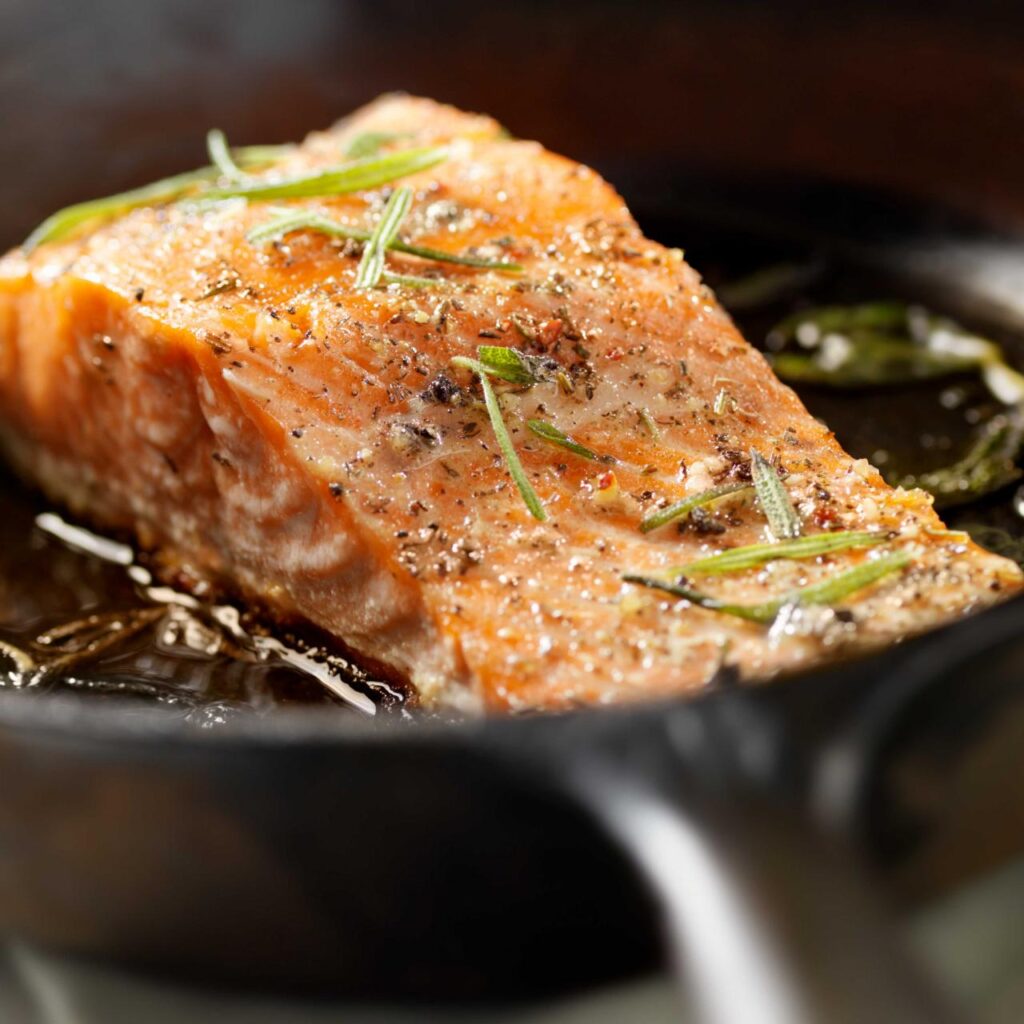
Cooking frozen salmon in an air fryer is straightforward and convenient. There’s no need to thaw the fish, which saves time and maintains its texture. The rapid circulation of hot air in an air fryer ensures that the salmon is cooked evenly, resulting in a crispy exterior while keeping the inside moist and tender. This technique is particularly beneficial for those who appreciate a well-cooked meal but have limited time to prepare one.
Furthermore, air frying frozen salmon requires minimal oil, reducing fat content significantly compared to traditional frying. This method not only simplifies the cooking process but also contributes to a healthier lifestyle, making it an excellent choice for a quick and nutritious meal.
Can You Air Fry Frozen Salmon?
Yes, you can definitely air fry frozen salmon, making it a quick and convenient option for a healthy meal. The air fryer works by circulating hot air around the food, cooking the salmon evenly and quickly without the need for defrosting.
This method not only saves time but also locks in moisture and flavor, resulting in a deliciously crisp exterior and tender interior. It’s a fantastic way to enjoy salmon that is both effortless to prepare and nutritious.
Kitchen Tools Needed
Ingredients for Air Fried Frozen Salmon
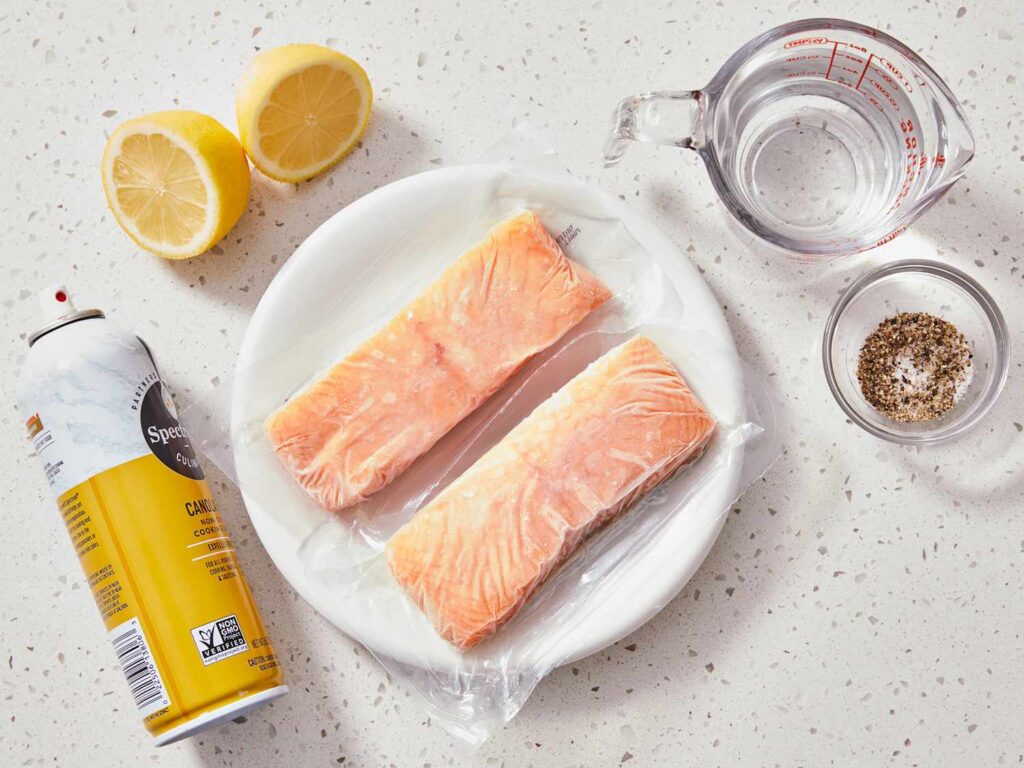
How To Make Air Fry Frozen Salmon?
Preparing the Air Fryer
Begin by preheating your air fryer to 400 degrees Fahrenheit. This ensures that the cooking environment is hot enough to start cooking the salmon fillets immediately, promoting a crispy exterior.
Seasoning the Salmon
While the air fryer is heating, take your frozen salmon fillets and lightly brush them with olive oil. This not only helps in cooking the salmon evenly but also aids in the adherence of the seasonings. Generously season both sides of the fillets with salt and pepper to taste. If you prefer, you can add other seasonings like garlic powder or paprika for extra flavor.
Cooking the Salmon
Place the salmon fillets in the air fryer basket. Make sure they are not overlapping to ensure even cooking. Cook the salmon for about 12 to 15 minutes. No need to thaw; the air fryer will cook the salmon perfectly from frozen. Halfway through the cooking time, open the air fryer and use tongs to carefully flip the fillets to ensure even cooking on both sides.
Checking Doneness
After the cooking time is complete, check the internal temperature of the salmon using a meat thermometer. The salmon should reach an internal temperature of 145 degrees Fahrenheit to ensure it is fully cooked and safe to eat.
Serving
Once cooked, remove the salmon fillets from the air fryer. If desired, garnish with fresh lemon slices and herbs such as dill or parsley. Serve immediately for the best flavor and texture, accompanied by your choice of side dishes like steamed vegetables or a fresh salad.
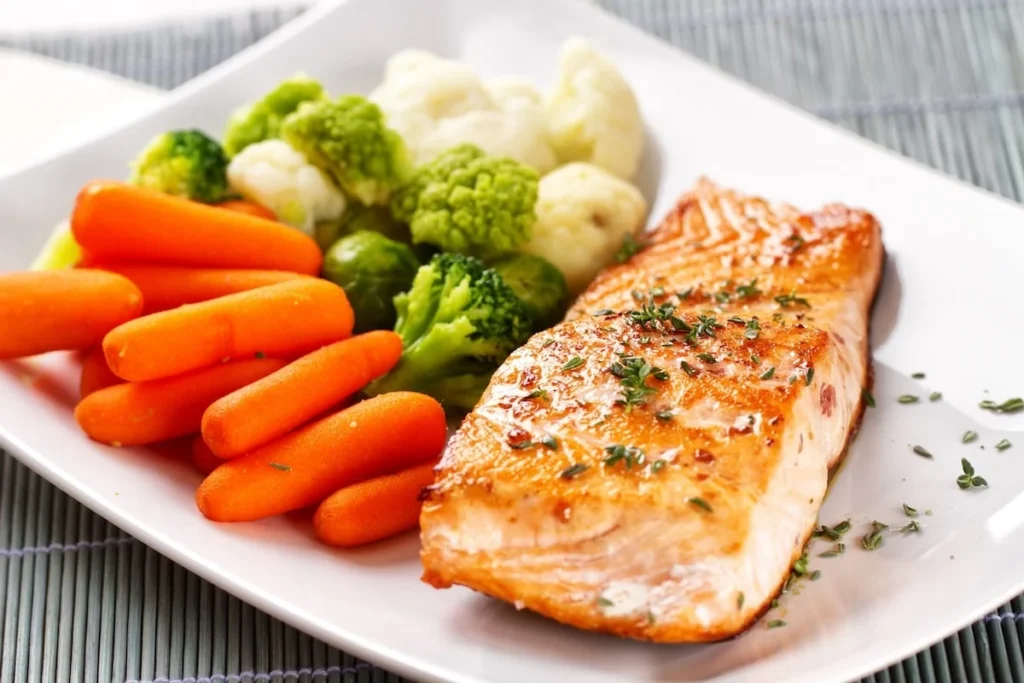
Serving Suggestions
Is There Any Difference Between Frozen And Fresh Air Fry Salmon?
Texture and Moisture: Fresh salmon typically offers a slightly better texture after cooking, as it retains more moisture, leading to a juicier result. Frozen salmon, especially if not vacuum-sealed, might lose some moisture during freezing and thawing, which can result in a slightly firmer or drier texture once cooked.
Convenience: Frozen salmon wins on convenience as it can be stored longer and cooked directly from frozen, saving time and reducing the need for planning ahead. Fresh salmon, while excellent in taste and texture, requires more immediate cooking or proper storage in the refrigerator and usually needs to be used within a day or two of purchase.
Flavor Integrity: Fresh salmon generally has a more vibrant and distinct salmon flavor, particularly if it has been handled and stored correctly. Frozen salmon might have a slightly subdued flavor, depending on the freezing process and the length of storage.
Cooking Time: Air frying fresh salmon can be quicker because you’re starting with a product at a higher initial temperature. Frozen salmon requires a bit more time in the air fryer to ensure it is cooked through evenly.

Health Benefits of Air-Frying Frozen Salmon
Nutrient Retention
Air-frying is known for its ability to retain more nutrients compared to traditional frying methods. Cooking frozen salmon in an air fryer preserves essential vitamins and minerals, including vitamin D, B vitamins, and omega-3 fatty acids. These nutrients are crucial for maintaining heart health, brain function, and overall well-being.
Lower Calorie Intake
Air-frying uses significantly less oil than traditional frying methods. This reduction in oil leads to lower calorie intake, which can be beneficial for weight management. Consuming fewer calories helps in maintaining a healthy weight, reducing the risk of obesity and associated diseases such as diabetes and cardiovascular conditions.
Reduced Risk of Heart Disease
Salmon is rich in omega-3 fatty acids, which are known for their heart-protective properties. These fatty acids help reduce inflammation, lower blood pressure, and decrease triglyceride levels. Air-frying frozen salmon ensures that these beneficial fats are preserved, contributing to improved cardiovascular health.
Enhanced Protein Intake
Salmon is an excellent source of high-quality protein, which is essential for muscle repair, growth, and overall body maintenance. Air-frying frozen salmon keeps the protein content intact, making it an ideal choice for those looking to increase their protein intake without adding unnecessary fats or calories.
Convenient and Quick Cooking
Air-frying frozen salmon is a convenient and time-efficient method. It eliminates the need for thawing, allowing you to cook the fish directly from frozen. This convenience ensures that you can enjoy a healthy meal even on busy days, making it easier to stick to a nutritious diet.
Improved Digestive Health
Salmon contains astaxanthin, a powerful antioxidant that promotes gut health by reducing inflammation and supporting the growth of beneficial gut bacteria. Air-frying frozen salmon helps retain this antioxidant, contributing to better digestive health and overall wellness.
Boosted Immune System
The high levels of vitamins and minerals in salmon, such as vitamin D and selenium, play a crucial role in supporting the immune system. Air-frying preserves these nutrients, helping to strengthen your body’s natural defenses against illnesses and infections.
Better Blood Sugar Control
Omega-3 fatty acids found in salmon have been shown to improve insulin sensitivity and reduce inflammation, which are essential for blood sugar control. Air-frying frozen salmon ensures that these beneficial fats are not lost during cooking, aiding in better management of blood sugar levels.
Reduced Exposure to Harmful Compounds
Traditional frying methods can produce harmful compounds like acrylamide and trans fats, which are linked to various health issues. Air-frying minimizes the formation of these compounds, making it a healthier cooking option that reduces your exposure to potentially harmful substances.
Enhanced Taste and Texture
Air-frying frozen salmon results in a crispy exterior and a tender, juicy interior, enhancing the overall eating experience. This method of cooking ensures that the fish retains its natural flavors and textures, making it a delicious and satisfying meal option that supports a healthy diet.
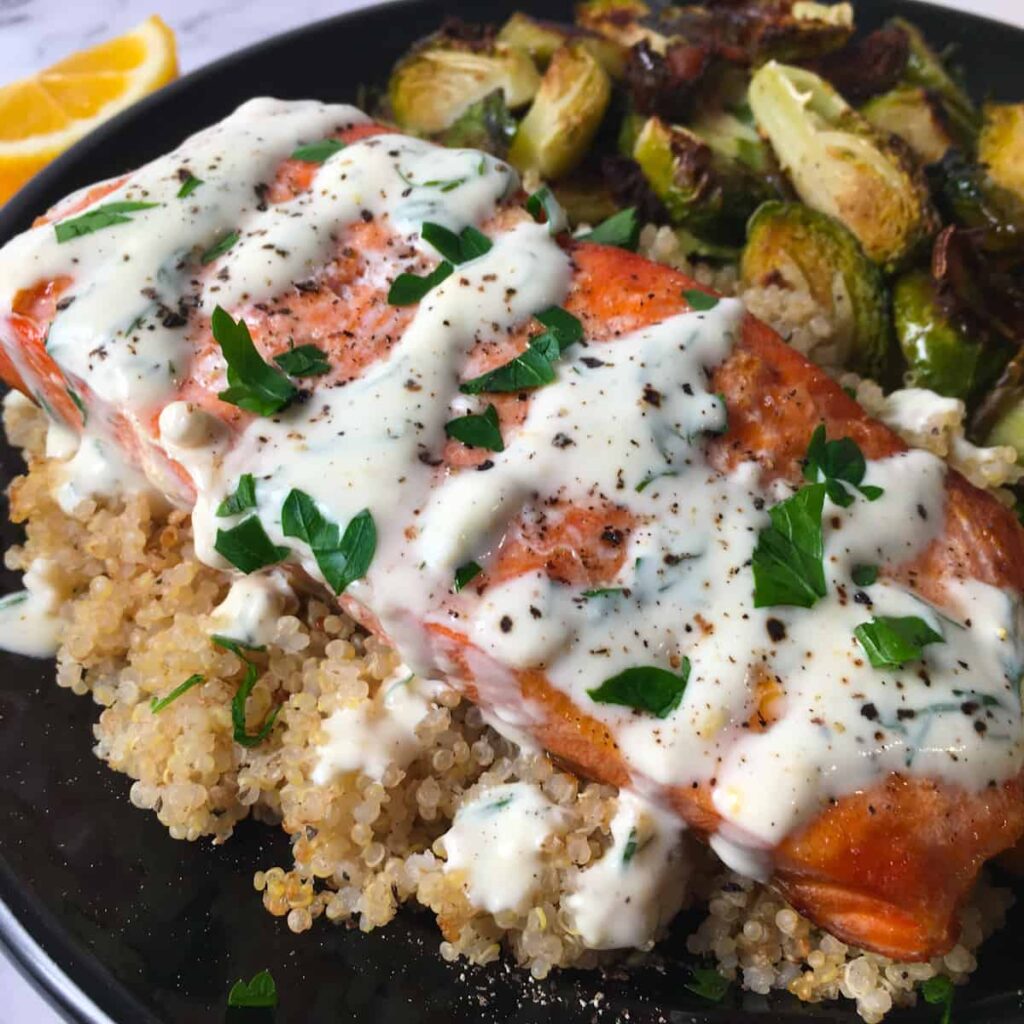
Tips For Best Results
Variations
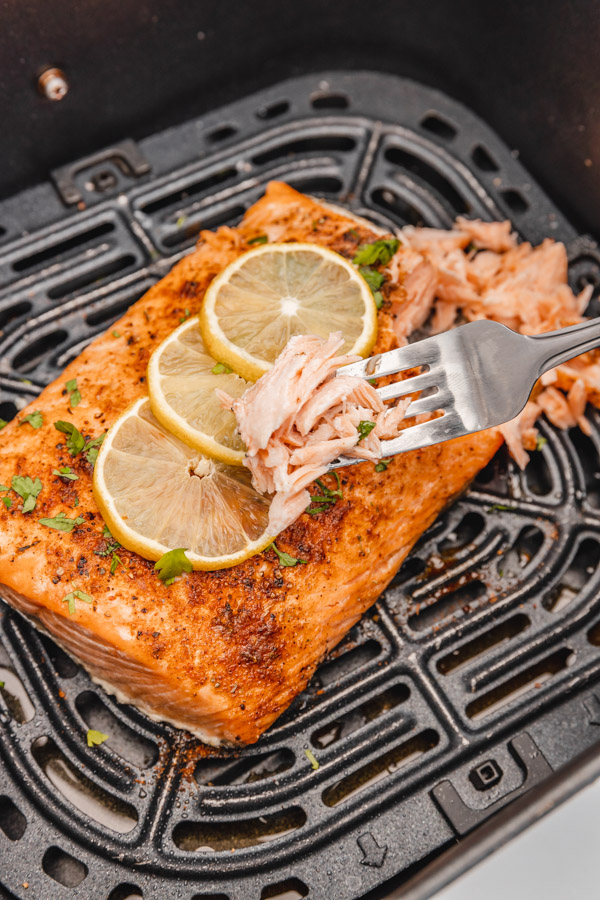
Substitutions
Making Ahead
Storage
Reheating
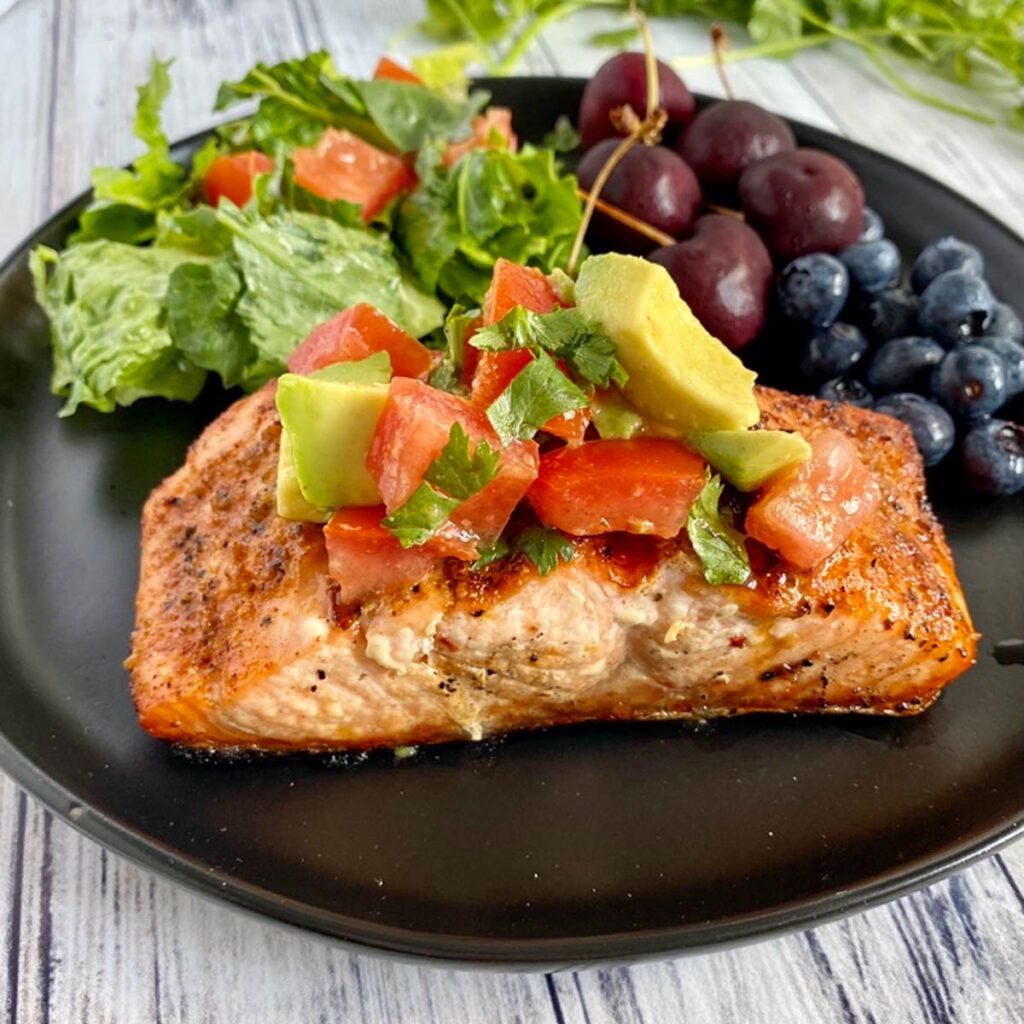
Delicious Salmon Recipes
Super Spicy Salmon Rice Muffins Recipe| Just 20 Minutes And Tasty Muffins Are Ready
Super Yummy Alaska Roll Sushi Recipe| 5 Best Sushi Sauces Recipes
Frequently Asked Questions – FAQ’s
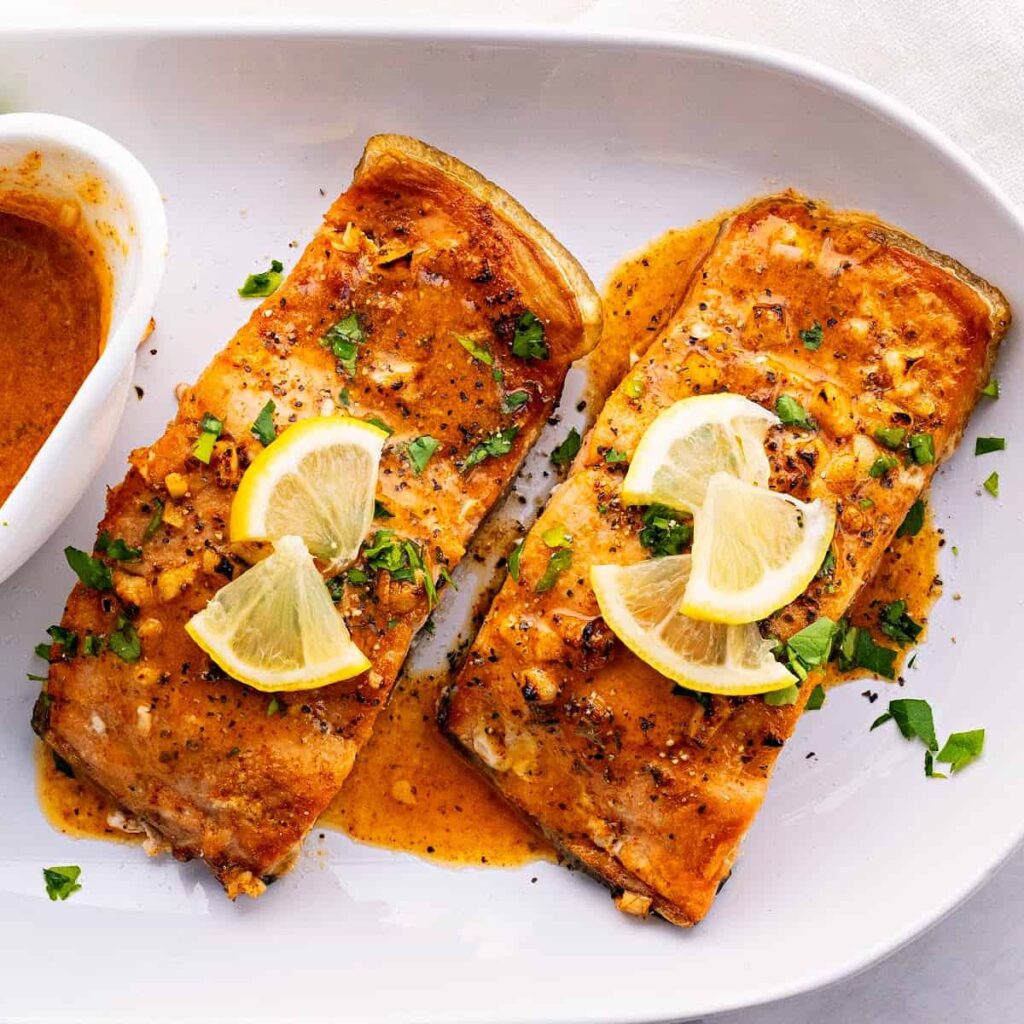
Air Fry Frozen Salmon
Course: MainCuisine: InternationalDifficulty: Easy4
servings15
minutes230
kcalIngredients
4 frozen salmon fillets (about 6 ounces each)
2 tablespoons olive oil (or another preferred oil)
Salt, to taste
Pepper, to taste
Optional: lemon slices and fresh herbs (like dill or parsley) for garnish
Directions
- Preparing the Air Fryer
- Begin by preheating your air fryer to 400 degrees Fahrenheit. This ensures that the cooking environment is hot enough to start cooking the salmon fillets immediately, promoting a crispy exterior.
- Seasoning the Salmon
- While the air fryer is heating, take your frozen salmon fillets and lightly brush them with olive oil. This not only helps in cooking the salmon evenly but also aids in the adherence of the seasonings. Generously season both sides of the fillets with salt and pepper to taste. If you prefer, you can add other seasonings like garlic powder or paprika for extra flavor.
- Cooking the Salmon
- Place the salmon fillets in the air fryer basket. Make sure they are not overlapping to ensure even cooking. Cook the salmon for about 12 to 15 minutes. No need to thaw; the air fryer will cook the salmon perfectly from frozen. Halfway through the cooking time, open the air fryer and use tongs to carefully flip the fillets to ensure even cooking on both sides.
- Checking Doneness
- After the cooking time is complete, check the internal temperature of the salmon using a meat thermometer. The salmon should reach an internal temperature of 145 degrees Fahrenheit to ensure it is fully cooked and safe to eat.
- Serving
- Once cooked, remove the salmon fillets from the air fryer. If desired, garnish with fresh lemon slices and herbs such as dill or parsley. Serve immediately for the best flavor and texture, accompanied by your choice of side dishes like steamed vegetables or a fresh salad.
Conclusion
Air frying frozen salmon stands out as a remarkable cooking method that combines convenience, health, and taste. It allows for a quick meal preparation without the need to thaw the salmon, making it an ideal choice for those with a busy lifestyle. Using minimal oil, the air fryer cooks the salmon evenly, creating a deliciously crispy exterior while keeping the interior moist and tender.
This technique not only preserves the nutritional value of the salmon but also makes it a heart-healthy option. With the ability to customize seasonings and marinades, air-fried salmon can suit a wide range of tastes, making it a versatile dish for any meal. Embrace this simple, effective cooking method to enjoy a gourmet-like salmon dish that impresses both in flavor and health benefits.







